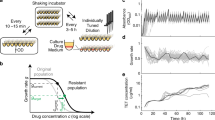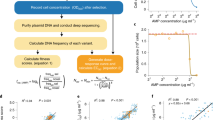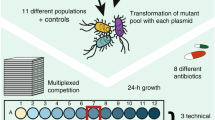Abstract
Epistasis, the non-additive effect of mutations, can provide combinatorial improvements to enzyme activity that substantially exceed the gains from individual mutations. Yet the molecular mechanisms of epistasis remain elusive, undermining our ability to predict pathogen evolution and engineer biocatalysts. Here we reveal how directed evolution of a β-lactamase yielded highly epistatic activity enhancements. Evolution selected four mutations that increase antibiotic resistance 40-fold, despite their marginal individual effects (≤2-fold). Synergistic improvements coincided with the introduction of super-stochiometric burst kinetics, indicating that epistasis is rooted in the enzyme’s conformational dynamics. Our analysis reveals that epistasis stemmed from distinct effects of each mutation on the catalytic cycle. The initial mutation increased protein flexibility and accelerated substrate binding, which is rate-limiting in the wild-type enzyme. Subsequent mutations predominantly boosted the chemical steps by fine-tuning substrate interactions. Our work identifies an overlooked cause for epistasis: changing the rate-limiting step can result in substantial synergy that boosts enzyme activity.

This is a preview of subscription content, access via your institution
Access options
Access Nature and 54 other Nature Portfolio journals
Get Nature+, our best-value online-access subscription
$29.99 / 30 days
cancel any time
Subscribe to this journal
Receive 12 digital issues and online access to articles
$119.00 per year
only $9.92 per issue
Buy this article
- Purchase on Springer Link
- Instant access to full article PDF
Prices may be subject to local taxes which are calculated during checkout



Similar content being viewed by others

Data availability
Cryogenic crystal structures are deposited at the Protein Data Bank under the PDB IDs 8PEA (F72L), 8PEB (Q5) and 8PEC (Q5-CAZ). Jupyter notebooks and input files required to replicate the MD simulations and analyses of the OXA-48 variants, as well as trajectories and MD snapshots, are available on the University of Bristol Research Data Storage Facility (RDSF) at https://doi.org/10.5523/bris.phtj9yrbdkrq2t6n53k84evkg. The repository furthermore contains PDB structures of all ensemble refinements presented in this work. All other data are available from the authors upon reasonable request. Source data are provided with this paper.
References
Miton, C. M., Buda, K. & Tokuriki, N. Epistasis and intramolecular networks in protein evolution. Curr. Opin. Struct. Biol. 69, 160–168 (2021).
Miton, C. M., Chen, J. Z., Ost, K., Anderson, D. W. & Tokuriki, N. Statistical analysis of mutational epistasis to reveal intramolecular interaction networks in proteins. Methods Enzymol. 643, 243–280 (2020).
Miton, C. M. & Tokuriki, N. How mutational epistasis impairs predictability in protein evolution and design. Protein Sci. 25, 1260–1272 (2016).
Khersonsky, O. & Tawfik, D. S. Enzyme promiscuity: a mechanistic and evolutionary perspective. Annu. Rev. Biochem 79, 471–505 (2010).
Buda, K., Miton, C. M. & Tokuriki, N. Higher-order epistasis creates idiosyncrasy, confounding predictions in protein evolution. Nat. Commun. https://doi.org/10.1038/s41467-023-44333-5 (2023).
Yang, G. et al. Higher-order epistasis shapes the fitness landscape of a xenobiotic-degrading enzyme. Nat. Chem. Biol. 15, 1120–1128 (2019).
Weinreich, D. M., Delaney, N. F., Depristo, M. A. & Hartl, D. L. Darwinian evolution can follow only very few mutational paths to fitter proteins. Science 312, 111–114 (2006).
Meini, M. R., Tomatis, P. E., Weinreich, D. M. & Vila, A. J. Quantitative description of a protein fitness landscape based on molecular features. Mol. Biol. Evol. 32, 1774–1787 (2015).
Campbell, E. C. et al. Laboratory evolution of protein conformational dynamics. Curr. Opin. Struct. Biol. 50, 49–57 (2018).
Romero-Rivera, A., Garcia-Borras, M. & Osuna, S. Role of conformational dynamics in the evolution of retro-aldolase activity. ACS Catal. 7, 8524–8532 (2017).
Sethi, A., Eargle, J., Black, A. A. & Luthey-Schulten, Z. Dynamical networks in tRNA:protein complexes. Proc. Natl Acad. Sci. USA 106, 6620–6625 (2009).
Jimenez-Oses, G. et al. The role of distant mutations and allosteric regulation on LovD active site dynamics. Nat. Chem. Biol. 10, 431–436 (2014).
Otten, R. et al. How directed evolution reshapes the energy landscape in an enzyme to boost catalysis. Science 370, 1442–1446 (2020).
Ortlund, E. A., Bridgham, J. T., Redinbo, M. R. & Thornton, J. W. Crystal structure of an ancient protein: evolution by conformational epistasis. Science 317, 1544–1548 (2007).
Gonzalez, M. M., Abriata, L. A., Tomatis, P. E. & Vila, A. J. Optimization of conformational dynamics in an epistatic evolutionary trajectory. Mol. Biol. Evol. 33, 1768–1776 (2016).
Rossi, M.-A., Palzkill, T., Almeida, F. C. L. & Vila, A. J. Slow protein dynamics elicits new enzymatic functions by means of epistatic interactions. Mol. Biol. Evol. 39, msac194 (2022).
Liao, Q. et al. Loop motion in triosephosphate isomerase is not a simple open and shut case. J. Am. Chem. Soc. 140, 15889–15903 (2018).
Dellus-Gur, E. et al. Negative epistasis and evolvability in TEM-1 β-lactamase—the thin line between an enzyme’s conformational freedom and disorder. J. Mol. Biol. 427, 2396–2409 (2015).
Kries, H., Bloch, J. S., Bunzel, H. A., Pinkas, D. M. & Hilvert, D. Contribution of oxyanion stabilization to kemp eliminase efficiency. ACS Catal. 10, 4460–4464 (2020).
Buller, A. R. et al. Directed evolution mimics allosteric activation by stepwise tuning of the conformational ensemble. J. Am. Chem. Soc. 140, 7256–7266 (2018).
Zeymer, C., Zschoche, R. & Hilvert, D. Optimization of enzyme mechanism along the evolutionary trajectory of a computationally designed (retro-)aldolase. J. Am. Chem. Soc. 139, 12541–12549 (2017).
Blazeck, J. et al. Bypassing evolutionary dead ends and switching the rate-limiting step of a human immunotherapeutic enzyme. Nat. Catal. 5, 952–967 (2022).
Fröhlich, C. et al. Cryptic β-lactamase evolution is driven by low β-lactam concentrations. mSphere 6, e00108–e00121 (2021).
Fröhlich, C. et al. OXA-48-mediated ceftazidime-avibactam resistance is associated with evolutionary trade-offs. mSphere 4, e00024–19 (2019).
Stojanoski, V. et al. Mechanistic basis of OXA-48-like β-lactamases’ hydrolysis of carbapenems. ACS Infect. Dis. 7, 445–460 (2021).
Tooke, C. L. et al. β-Lactamases and β-lactamase inhibitors in the 21st century. J. Mol. Biol. 431, 3472–3500 (2019).
Pitout, J. D. D., Peirano, G., Kock, M. M., Strydom, K. A. & Matsumura, Y. The global ascendency of OXA-48-type carbapenemases. Clin. Microbiol Rev. 33, e00102–e00119 (2019).
Hirvonen, V. H. A., Mulholland, A. J., Spencer, J. & van der Kamp, M. W. Small changes in hydration determine cephalosporinase activity of OXA-48 β-lactamases. ACS Catal. 10, 6188–6196 (2020).
Bunzel, H. A., Anderson, J. L. R. & Mulholland, A. J. Designing better enzymes: insights from directed evolution. Curr. Opin. Struct. Biol. 67, 212–218 (2021).
Naas, T. et al. β-Lactamase database (BLDB)—structure and function. J. Enzym. Inhib. Med Chem. 32, 917–919 (2017).
Tacao, M., Silva, I. & Henriques, I. Culture-independent methods reveal high diversity of OXA-48-like genes in water environments. J. Water Health 15, 519–525 (2017).
Knies, J. L., Cai, F. & Weinreich, D. M. Enzyme efficiency but not thermostability drives cefotaxime resistance evolution in TEM-1 β-lactamase. Mol. Biol. Evol. 34, 1040–1054 (2017).
Gonzalez, L. J., Bahr, G., Gonzalez, M. M., Bonomo, R. A. & Vila, A. J. In-cell kinetic stability is an essential trait in metallo-β-lactamase evolution. Nat. Chem. Biol. 19, 1116–1126 (2023).
Page, M. G. P. The kinetics of non-stoichiometric bursts of β-lactam hydrolysis catalysed by class C β-lactamases. Biochem J. 295, 295–304 (1993).
Page, M. G. P. Extended-spectrum β-lactamases: structure and kinetic mechanism. Clin. Microbiol. Infect. 14, 63–74 (2008).
Ledent, P. & Frère, J. M. Substrate-induced inactivation of the OXA2 β-lactamase. Biochem J. 295, 871–878 (1993).
Vogt, A. D. & Di Cera, E. Conformational selection or induced fit? A critical appraisal of the kinetic mechanism. Biochemistry 51, 5894–5902 (2012).
King, D. T., King, A. M., Lal, S. M., Wright, G. D. & Strynadka, N. C. Molecular mechanism of avibactam-mediated β-lactamase inhibition. ACS Infect. Dis. 1, 175–184 (2015).
Tooke, C. L. et al. Tautomer-specific deacylation and Ω-loop flexibility explain the carbapenem-hydrolyzing broad-spectrum activity of the KPC-2 β-lactamase. J. Am. Chem. Soc. 145, 7166–7180 (2023).
Docquier, J. D. et al. Crystal structure of the OXA-48 β-lactamase reveals mechanistic diversity among class D carbapenemases. Chem. Biol. 16, 540–547 (2009).
Schneider, S. H., Kozuch, J. & Boxer, S. G. The interplay of electrostatics and chemical positioning in the evolution of antibiotic resistance in TEM β-lactamases. ACS Cent. Sci. 7, 1996–2008 (2021).
Bunzel, H. A. et al. Evolution of dynamical networks enhances catalysis in a designer enzyme. Nat. Chem. 13, 1017–1022 (2021).
Buda, K., Miton, C. M., Fan, X. C. & Tokuriki, N. Molecular determinants of protein evolvability. Trends Biochem. Sci. 48, 751–760 (2023).
Tokuriki, N. & Tawfik, D. S. Protein dynamism and evolvability. Science 324, 203–207 (2009).
Tamer, Y. T. et al. High-order epistasis in catalytic power of dihydrofolate reductase gives rise to a rugged fitness landscape in the presence of trimethoprim selection. Mol. Biol. Evol. 36, 1533–1550 (2019).
Palzkill, T. Structural and mechanistic basis for extended-spectrum drug-resistance mutations in altering the specificity of TEM, CTX-M, and KPC β-lactamases. Front. Mol. Biosci. 5, 16 (2018).
Maria-Solano, M. A., Serrano-Hervas, E., Romero-Rivera, A., Iglesias-Fernandez, J. & Osuna, S. Role of conformational dynamics in the evolution of novel enzyme function. Chem. Commun. 54, 6622–6634 (2018).
Campbell, E. et al. The role of protein dynamics in the evolution of new enzyme function. Nat. Chem. Biol. 12, 944–950 (2016).
Fröhlich, C., Sørum, V., Tokuriki, N., Johnsen, P. J. & Samuelsen, Ø. Evolution of β-lactamase-mediated cefiderocol resistance. J. Antimicrob. Chemother. 25, 2429–2436 (2022).
Lund, B. A., Christopeit, T., Guttormsen, Y., Bayer, A. & Leiros, H. K. Screening and design of inhibitor scaffolds for the antibiotic resistance oxacillinase-48 (OXA-48) through surface plasmon resonance screening. J. Med. Chem. 59, 5542–5554 (2016).
Lund, B. A. et al. The biological assembly of OXA-48 reveals a dimer interface with high charge complementarity and very high affinity. FEBS J. 285, 4214–4228 (2018).
Kabsch, W. XDS. Acta Crystallogr. D 66, 125–132 (2010).
Evans, P. R. & Murshudov, G. N. How good are my data and what is the resolution? Acta Crystallogr. D 69, 1204–1214 (2013).
Adams, P. D. et al. PHENIX: a comprehensive Python-based system for macromolecular structure solution. Acta Crystallogr. D 66, 213–221 (2010).
Emsley, P., Lohkamp, B., Scott, W. G. & Cowtan, K. Features and development of Coot. Acta Crystallogr. D 66, 486–501 (2010).
Case, D. A. et al. AMBER 2018 (University of California, San Francisco, 2018).
Le Grand, S., Gotz, A. W. & Walker, R. C. SPFP: speed without compromise—a mixed precision model for GPU accelerated molecular dynamics simulations. Comput. Phys. Commun. 184, 374–380 (2013).
Salomon-Ferrer, R., Gotz, A. W., Poole, D., Le Grand, S. & Walker, R. C. Routine microsecond molecular dynamics simulations with AMBER on GPUs. 2. Explicit solvent particle mesh Ewald. J. Chem. Theory Comput. 9, 3878–3888 (2013).
Maier, J. A. et al. ff14SB: improving the accuracy of protein side chain and backbone parameters from ff99SB. J. Chem. Theory Comput. 11, 3696–3713 (2015).
Vanquelef, E. et al. R.E.D. Server: a web service for deriving RESP and ESP charges and building force field libraries for new molecules and molecular fragments. Nucleic Acids Res. 39, W511–W517 (2011).
Roe, D. R. & Cheatham, T. E. 3rd PTRAJ and CPPTRAJ: software for processing and analysis of molecular dynamics trajectory data. J. Chem. Theory Comput. 9, 3084–3095 (2013).
McGibbon, R. T. et al. MDTraj: a modern open library for the analysis of molecular dynamics trajectories. Biophys. J. 109, 1528–1532 (2015).
Pedregosa, F. et al. Scikit-learn: machine learning in Python. J. Mach. Learn. Res. 12, 2825–2830 (2011).
Acknowledgements
MD simulations were conducted using the computational facilities of the Advanced Computing Research Centre, University of Bristol. C.F. thanks the PhD schools NFIF, IBA and Biocat for their funding. H.A.B. thanks the SNSF for funding (P5R5PB_210999, PZ00P3_208691 and P400PB_194329). M.W.v.d.K. thanks BBSRC for funding (BB/M026280/1). N.T. thanks the Canadian Institute of Health Research (CIHR) for the project grant (AWD-019305). H.-K.S.L. thanks the Centre for New Antibacterial Strategies for the project grant. This work is part of a project that has received funding from the European Research Council under the European Horizon 2020 research and innovation programme (PREDACTED Advanced Grant Agreement no. 101021207) to A.J.M. A.J.M. and H.A.B. also thank BBSRC (grant no. BB/R016445/1) and EPSRC (EP/M013219/1 and EP/M022609/1) for funding. This work was carried out using the computational facilities of the Advanced Computing Research Centre, University of Bristol (http://www.bris.ac.uk/acrc/).
Author information
Authors and Affiliations
Contributions
C.F., H.A.B. and N.T. conceived the study. C.F. performed directed evolution, selection and cloning and assayed dose–response curves. C.F. and K.B. expressed and purified enzymes. C.F. determined thermostabilities. K.B., C.F. and H.A.B. assayed enzyme kinetics. K.B. and N.T. performed the statistical analysis. H.A.B. performed, and H.A.B., A.J.M. and M.W.v.d.K. analysed, the MD simulations. C.F. crystallized proteins, and C.F. and H.-K.S.L. solved structures and refined structures. C.F., H.A.B., P.J.J. and N.T. wrote the paper with input from all co-authors.
Corresponding authors
Ethics declarations
Competing interests
The authors declare no competing interests.
Peer review
Peer review information
Nature Catalysis thanks Canan Atilgan, Christos Karamitros, Alejandro J. Vila and the other, anonymous, reviewer(s) for their contribution to the peer review of this work.
Additional information
Publisher’s note Springer Nature remains neutral with regard to jurisdictional claims in published maps and institutional affiliations.
Supplementary information
Supplementary Information
Supplementary Figs. 1–16 and Tables 1–8.
Source data
Source Data Fig. 1
Source data for Fig. 1.
Source Data Fig. 2
Source data for Fig. 2.
Source Data Fig. 3
Source data for Fig. 3.
Rights and permissions
Springer Nature or its licensor (e.g. a society or other partner) holds exclusive rights to this article under a publishing agreement with the author(s) or other rightsholder(s); author self-archiving of the accepted manuscript version of this article is solely governed by the terms of such publishing agreement and applicable law.
About this article
Cite this article
Fröhlich, C., Bunzel, H.A., Buda, K. et al. Epistasis arises from shifting the rate-limiting step during enzyme evolution of a β-lactamase. Nat Catal (2024). https://doi.org/10.1038/s41929-024-01117-4
Received:
Accepted:
Published:
DOI: https://doi.org/10.1038/s41929-024-01117-4


